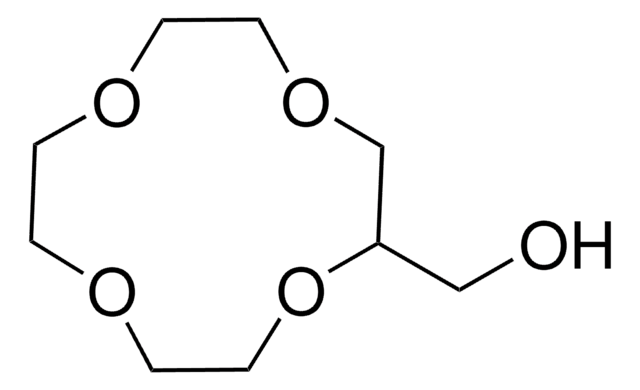This compound is a neat or pure liquid with a melting point of 16 °C. The product has not been diluted in any solvent or buffer.
194905
12-Crown-4
98%
Sinónimos:
1,4,7,10-Tetraoxacyclododecane
Seleccione un Tamaño
32,20 €
Seleccione un Tamaño
About This Item
32,20 €
Productos recomendados
Nivel de calidad
Ensayo
98%
Formulario
liquid
índice de refracción
n20/D 1.463 (lit.)
bp
61-70 °C/0.5 mmHg (lit.)
mp
16 °C (lit.)
densidad
1.089 g/mL at 25 °C (lit.)
grupo funcional
ether
cadena SMILES
C1COCCOCCOCCO1
InChI
1S/C8H16O4/c1-2-10-5-6-12-8-7-11-4-3-9-1/h1-8H2
Clave InChI
XQQZRZQVBFHBHL-UHFFFAOYSA-N
¿Está buscando productos similares? Visita Guía de comparación de productos
Descripción general
Aplicación
- A promoter in the synthesis of poly(diethylsiloxane) (PDES) from monomer hexaethylcyclotrisiloxane using NaOH as a catalyst via anionic ring-opening polymerization.[4]
- As an additive in the preparation of triarylmethane derivatives by palladium-catalyzed cross coupling reaction of aryl bromides with diarylmethane derivatives.[5]
- A phase transfer catalyst in organic synthesis.[6]
Palabra de señalización
Danger
Frases de peligro
Consejos de prudencia
Clasificaciones de peligro
Acute Tox. 1 Inhalation
Código de clase de almacenamiento
6.1A - Combustible acute toxic Cat. 1 and 2 / very toxic hazardous materials
Clase de riesgo para el agua (WGK)
WGK 3
Punto de inflamabilidad (°F)
235.4 °F - closed cup
Punto de inflamabilidad (°C)
113 °C - closed cup
Equipo de protección personal
Eyeshields, Faceshields, Gloves, type ABEK (EN14387) respirator filter
Elija entre una de las versiones más recientes:
¿Ya tiene este producto?
Encuentre la documentación para los productos que ha comprado recientemente en la Biblioteca de documentos.
-
Regarding product 194905- 12-Crown-4. I received the product in liquid form, as mentioned. I want to know in which liquid the 12-Crown-4 is dissolved.Is it in any solvent or water?
1 respuesta-
¿Le ha resultado útil?
-
-
How can I determine the shelf life / expiration / retest date of this product?
1 respuesta-
If this product has an expiration or retest date, it will be shown on the Certificate of Analysis (COA, CofA). If there is no retest or expiration date listed on the product's COA, we do not have suitable stability data to determine a shelf life. For these products, the only date on the COA will be the release date; a retest, expiration, or use-by-date will not be displayed.
For all products, we recommend handling per defined conditions as printed in our product literature and website product descriptions. We recommend that products should be routinely inspected by customers to ensure they perform as expected.
For products without retest or expiration dates, our standard warranty of 1 year from the date of shipment is applicable.
For more information, please refer to the Product Dating Information document: https://www.sigmaaldrich.com/deepweb/assets/sigmaaldrich/marketing/global/documents/449/386/product-dating-information-mk.pdf¿Le ha resultado útil?
-
-
How is shipping temperature determined? And how is it related to the product storage temperature?
1 respuesta-
Products may be shipped at a different temperature than the recommended long-term storage temperature. If the product quality is sensitive to short-term exposure to conditions other than the recommended long-term storage, it will be shipped on wet or dry-ice. If the product quality is NOT affected by short-term exposure to conditions other than the recommended long-term storage, it will be shipped at ambient temperature. As shipping routes are configured for minimum transit times, shipping at ambient temperature helps control shipping costs for our customers. For more information, please refer to the Storage and Transport Conditions document: https://www.sigmaaldrich.com/deepweb/assets/sigmaaldrich/marketing/global/documents/316/622/storage-transport-conditions-mk.pdf
¿Le ha resultado útil?
-
Filtros activos
Nuestro equipo de científicos tiene experiencia en todas las áreas de investigación: Ciencias de la vida, Ciencia de los materiales, Síntesis química, Cromatografía, Analítica y muchas otras.
Póngase en contacto con el Servicio técnico








